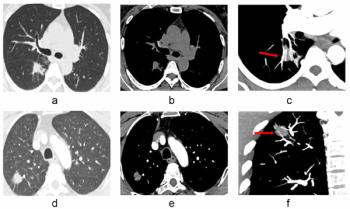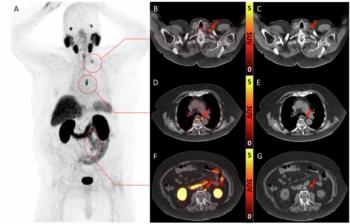
Color comes to low-res diagnostic-quality monitors
Although color monitors are the standard for high-end workstations in the print and information technology industries, gray-scale displays are the mainstay for diagnostic reading and review, simply because they are brighter.
Although color monitors are the standard for high-end workstations in the print and information technology industries, gray-scale displays are the mainstay for diagnostic reading and review, simply because they are brighter.
Diagnostic-quality 2-megapixel color monitors are finally coming to market, however, now that technology has made it possible to produce brightness levels comparable to those of gray-scale displays. Prices are nearly the same as for gray-scale units. The 2-MP color displays are meeting the growing demand for color to navigate PACS software interfaces, review cross-sectional images in the OR, ER, or clinic, and read low-resolution ultrasound, PET, or nuclear medicine scans in the radiology department.
"Through improvements in LCD technology and efficient backlights, we're able to build color monitors that are starting to achieve the brightness levels of their gray-scale counterparts and provide the same luminance and contrast ratios people are used to with gray scale," said Patrick Herguth, vice president and general manager of the medical business unit for Planar. "And we're able to do that at similar price points as the gray-scale monitors."
Color options for radiologists' workhorse 3-MP displays will carry a price premium, at least over the next one to five years, because there are no market forces to drive down cost, said Reinhard Braeuer, director of sales for Siemens Engineering Display Technologies.
"Radiology is one of the only niche market groups that is requesting gray-scale monitors. If this market segment goes to color, not only will that lower the cost [of color monitors] in the future," said Todd Fender, specialty marketing product line manager for NEC Display Solutions. "It will also help bring new technology to the marketplace quicker because monitor manufacturers will not have to focus on producing gray-scale monitors."
Medical-grade 2-MP color monitors, which were prominent at the 2005 RSNA meeting, do not achieve the same brightness levels as their gray-scale counterparts. Their level of brightness, however, is within acceptable limits, according to industry experts.
The SHD 21205 2-MP, 21.3-inch, high bright color, flat-panel display from Siemens achieves brightness levels up to 400 candela and can be used in a relatively bright environment. The 2-MP gray-scale monitor from Planar has a maximum luminance of 800 to 1000 nits. Its color monitor has a maximum luminance of 600 nits and can sustain brightness at 400 to 500 nits.
Diagnostic-quality 2-MP color displays are priced at or even slightly below the cost of gray-scale displays. The cost of Planar's 2-MP gray-scale monitor is $10,000. The equivalent 2-MP high bright color monitor costs $9500, Herguth said.
Prices for 2-MP color monitors are lower because manufacturers have been able to leverage components used in less demanding displays. Planar offset the cost of building a customized backlight to bring a high bright color 2-MP monitor to the medical market by using commercial LCD glass, which is cheaper than medical-specific gray-scale glass, Herguth said.
A 4-MP color medical-grade monitor, which received 510k certification from the FDA in early February of this year, will carry the same price tag as the company's dual 2-MP gray-scale monitors ($10,000) because 4-MP components were introduced for a high-end commercial application and costs could be spread across markets outside of medicine.
The overall market for 3-MP color monitors is too small at present, however, to find opportunities for leveraging the high costs of custom-built backlight LCD components. Fender explained that color monitors for diagnostic medical purposes have overdriven backlights or a different type of backlight from standard monitors to compensate for their color filter, which dampens brightness. The cost of the color filters and the backlight architecture to increase brightness bumps up the price of 3-MP color displays.
Diagnostic-quality color monitors also are more costly because they need specialized electronic elements, such as an integrated photometer that continuously monitors and adjusts luminance levels, DICOM curves, and lookup application curves that allow a radiologist to switch from one application to another without recalibrating, as well as a backup power supply.
Adding to the cost of developing medical-grade monitors is the need to pass muster with the FDA and meet other certifications, such as UL 60601, as well as the requirements of the American Association of Physicists and radiology specialty societies.
In addition to a 5-MP medical-grade gray-scale monitor that is expected to be launched by the end of this year, NEC is developing a 3-MP high bright color monitor with a light-emitting diode backlight. The company has chosen LED technology to eliminate mercury, which is common in cold cathode fluorescent lamps, and obtain consistent and uniform brightness over the life of the monitor. Costs to produce this color option are probably one and a half times higher than those of gray-scale alternatives.
In the short term, at least, color monitors will likely be adopted by the traditional 2-MP buying market segment, which includes imaging centers, Herguth said. In the 3-MP workstation space, where radiologists need a high contrast ratio to do their computed radiography and x-ray work, the switch to color monitors will take longer, as long as costs for high performance units remain high.
"I don't think people will pay more for color. But as the color specs start to close the gap, you'll start to see a stronger transition," Herguth said. "It will remain gray scale for the primary general-purpose reading workstation, which is a 3-MP space. In clinics and outside radiology, where people are doing mostly cross-sectional imaging, you will see a wide adoption of color, to the point where we'll see more 2-MP color products than gray scales very soon."
He predicted the imaging community is still a year or two away from any widespread purchasing of color monitors offering 3-MP or 5-MP quality.
Newsletter
Stay at the forefront of radiology with the Diagnostic Imaging newsletter, delivering the latest news, clinical insights, and imaging advancements for today’s radiologists.






























